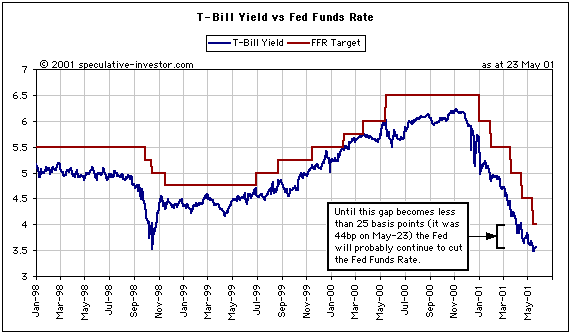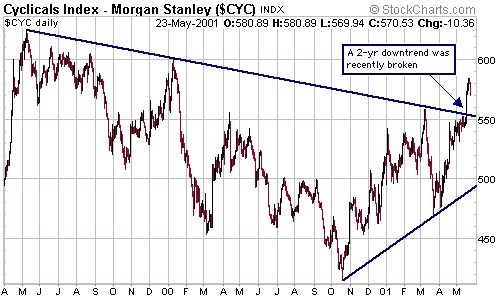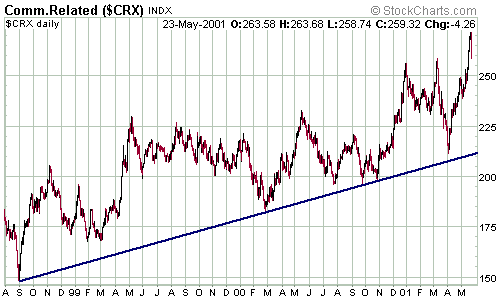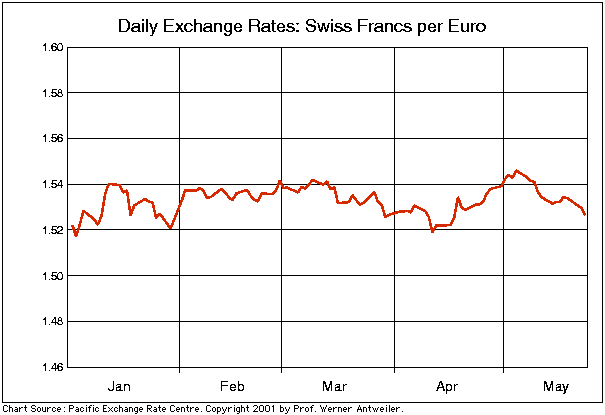|
- 23 May 2001
Interest
Rate Update
Short-term Interest Rates
The chart below shows the yield on
13-week T-Bills versus the target Fed Funds Rate (FFR) set by Greenspan
& Co. Note how closely these rates move together and also note that
the T-Bill yield tends to lead. Unless the T-Bill yield moves higher over
the next month, another official rate cut at the next FOMC Meeting (June
26/27) is likely.

As soon as the market senses that the
Fed has done enough with short-term rates to stimulate an economic recovery
later this year, the T-Bill yield will begin to move higher. This is why
we are paying close attention to short-term market interest rates - they
will put us on notice that the economic rebound that is already being discounted
by the stock market is about to get underway.
However, things may not be as simple
as they seem (are they ever?). Although it is normal for the T-Bill yield
to respond to economic growth and for the Fed to follow closely behind,
excessive Dollar strength or a financial system problem could prompt the
Fed to push short-term rates much lower than the economy requires (as happened
in 1991-1992 when the Fed's overriding concern was inadequate capital in
the banking system).
Dollar strength is sure to be a major
concern at the moment, regardless of the on-going verbal support of the
strong dollar policy. However, if the story unfolds as we think it will
over the next 2 months then Dollar strength is not going to be an issue
(beyond the very short-term) and the June FOMC Meeting will provide the
final rate cut of this cycle. If we are wrong about the Dollar and it continues
to strengthen over the next few months then we would expect to see the
Fed drive short-term rates lower in an attempt to weaken the Dollar.
The US
Stock Market
The Economy and the Markets
When we look at the following charts
showing the performances of cyclical stocks and commodity-related stocks
we just can't believe that there is so much concern about the health of
the economy and so little concern about inflation.


Alan Greenspan has spent much of his
adult life looking for the 'holy grail' of economic statistics, some indicator
that will reliably forecast the future direction of the economy. He has
experimented with countless complex formulae in his search, but seems incapable
of recognising simple messages from the financial markets.
In our opinion, one of the reasons
the financial markets are usually (not always, but usually) reliable leading
indicators of the economy is that almost no-one believes them when they
are signaling a change. This general disbelief most likely stems from the
fact that the messages sent by the financial markets tend to be their most
powerful when they appear to be completely irrational. When bonds began
to rally with the economy so clearly going 'gangbusters' in Q1 2000, and
when economically-sensitive stocks began to rally late last year just as
it was becoming obvious that the economy was about to fall off a cliff,
most people (those who noticed, anyway) tried to explain-away the apparently
anomalous behaviour of the markets. However, rather than explaining-away
today's market behaviour because it seems to be completely at odds with
the fundamental backdrop, it usually pays to listen to the markets as they
could be giving us a 'heads-up' on what the fundamental backdrop will look
like in 6-12 months time.
By the way, cyclical and commodity-related
stocks are probably close to medium-term peaks. We expect these stocks
to pullback towards their up-trend lines over the next few months.
Current Market Situation
It is likely that there will be another
bounce over the next week that takes the NASDAQ Composite and the S&P500
above their recent peaks, but there is no need to try to finesse the short-term
peak in the market. Our goals for the April-May rally were achieved and,
as per E-mail Alert #34, we took profits on our QQQ shares following Monday's
NASDAQ surge. We are retaining other tech stocks to maintain some exposure
to any further upside.
In the May-07 WMU we forecast that
a correction would probably begin by early-June and this is still our expectation.
Although we noted that this correction could take back as much as 75% of
the preceding gains, we do not expect such a large retracement. Our assessment
of the sentiment picture is that there is still a healthy amount of skepticism
under the surface, as particularly indicated by the surge in put-option
buying that occurs every time the market dips. This lack of conviction
(conviction is always the strongest at the top and the bottom) suggests
that the coming correction will take back less than 50% of the preceding
gains.
Gold and
the Dollar
Gold Sentiment
Even before the pullback in gold and
gold stocks over the past 2 days, the prevailing attitude towards gold's
latest bounce could be described as 'skepticism bordering on contempt'.
This is bullish. The longer that gold can rally without attracting much
in the way of positive press, the better.
Over the past few days we've seen the
long-term gold chart trotted-out on a couple of occasions by analysts to
show that the recent up-move doesn't even register on the chart. This is,
of course, true - the rally of the past 2 weeks is undetectable on a 25-year
chart. In order to make an impact on a very long-term chart the gold price
would need to move to around $400. If it is going to take that level of
move to prompt many analysts and commentators to question their beliefs,
then that's fine by us.
The following extracts from two recent
articles accurately portray the current sentiment.
1) May-22 Reuters article: Gold Rise
May Not Hold
This rally, like several speculative
rallies in the past few years, does not have the legs to last, say analysts.
Gold has weak-long term fundamentals,
from sluggish jewelry demand to an ever present overcapacity threat. Central
bankers remain large net sellers of gold.
After recent highs, investors are
being tempted to take profits, putting the brakes on any
long-term rally. Analysts are waiting
to see if there is any follow-through but are not holding their breath.
"There is a good chance this rally
will stagger," said HSBC Securities analyst Victor Flores. "If the rally
does not last, you will see profit taking."
2) An article by Merrill Lynch's Bill
O'Neill on May-15 (written immediately prior to last week's $18 surge)
Obviously, surging energy prices
and severe equity market weakness have not helped gold's cause as the metal's
price fell to 20-year lows while crude oil tripled, natural gas rose five
fold and many global stock markets saw precipitous losses and we maintain
that gold has been mostly demonitzed [sic]. When it comes to commodities,
gold seems to look at the big picture which is
non-inflationary ex-energy and
that is only if you believe gold is actually responding to commodities.
At this juncture, there seems little
of a compelling nature to cause to alter the 3-month trading range forecast
of $250 to $282 as detailed in the May 4 Commodity Market Trends report
and our view toward gold remains mostly neutral. Today's lackluster 20
tonne UK gold auction which sold at 5 cents below the London gold fix of
$268.05 is yet another example of the lack of real enthusiasm for the metal.
Selling gold near $260 is not optimal from a risk/reward basis but that
is far from a bullish endorsement.
The Enigmatic Dollar
We do not believe that recent US$ strength
is the result of flight-to-safety buying and do not see signs of an imminent
currency crisis. Both the inability of the Dollar to break lower earlier
this year and the recent rally are most likely the result of highly-leveraged
speculation in the credit market. How do we know? We can't know for sure,
but if we were seeing flight-to-safety buying or a developing currency
crisis then:
a) US Treasury Bonds, the ultimate
safe haven in the fiat currency world, would be much stronger than they
are, and
b) global stock markets would be far
more unsettled than they are.
If we are correct then these leveraged
speculative bets in the credit market are going to be unwound in the months
ahead and the Dollar will be forced into a 'swan dive'.
Other plausible explanations for the
Dollar's strength are provided in an article by Hans Sennholz that can
be read at: http://www.sennholz.com/langeuro.html.
Professor Sennholz outlines two possible reasons for the Dollar's continuing
strength versus the euro. Firstly, he notes that the euro-zone governments
are using the introduction of the common currency as an opportunity to
seize and confiscate funds acquired illegally, thus forcing holders of
such funds to exchange their existing currency holdings for US Dollars
to avoid detection. Secondly, he mentions that millions of people outside
the euro-zone have savings denominated in currencies that must be converted
into euros at the end of this year, and that many of these people may be
fearful or uncertain regarding the conversion process.
Although Professor Sennholz's arguments
sound plausible and certainly should not be dismissed, the following chart
showing the euro in terms of the Swiss Franc since the beginning of this
year suggests that his explanations are not the main cause of current euro
weakness versus the Dollar. If euro weakness was primarily the result of
the approaching euro-zone currency conversion then we would expect that
the SF would have shown considerable relative strength against the euro
over the past several months. In actual fact, the euro-SF exchange rate
has been flat since the beginning of this year (the euro is actually slightly
higher now, versus the SF, than it was at the beginning of this year).

We therefore come back to our vague
explanation that leveraged speculations in the US credit market are driving
the Dollar higher. If we are correct then the Dollar should soon reverse
lower. If Professor Sennholz is correct then the Dollar could continue
its upward trajectory into year-end.
Current Market Situation
Over the past couple of weeks we've
noted that a final Dollar surge into late-May appeared likely, but that
a Dollar peak was imminent. There is no change to our view. From a cyclical
perspective next week is the most likely time for the Dollar to peak, although
its rapid speed of ascent may result in a peak this week.
As far as gold and gold stocks are
concerned, we doubt that the pullback that commenced at the beginning of
this week will extend much further. If the markets are intent on testing
the previous breakouts then we would see the gold price fall to around
275 and the XAU fall to around 57. However, if the market continues to
behave as it has done for the past few weeks then buying support will emerge
before these levels are reached.
For those who have insufficient exposure
to the gold sector we suggest buying HGMCY at around $5.60 and DROOY at
around $1.25 (or lower, if possible).
Administrative
Note
On Tuesday morning (Monday night in
the US) we sent out Market Alert #34 by e-mail. If you were a subscriber
as at 21st May and didn't receive this e-mail alert, then we probably don't
have your correct e-mail address in our records. Please ensure that we
have your correct e-mail address so that a) you can receive the market
alerts, and b) we can contact you regarding subscription details/changes.
Changes
to the TSI Portfolio
Both QQQ positions sold at $51.05 as
per E-mail Alert #34.

|

